- Hotline: 852+ 2891 9689
- Whatsapp: 852+ 9146 8426
- [email protected]
- 6/F 29 Austin Road, Tsimshatsui, Kowloon, Hong Kong
Serving You With 18 Years of Experience
From your first online assessment to full recovery, every step of your hair transplant journey matters. At our clinic, we take pride in guiding you through the entire process with medical precision, personal care, and proven results.
It all starts with a confidential online assessment to understand your hair loss concerns. This is followed by a thorough doctor consultation where we evaluate your scalp, discuss realistic goals, and customize a treatment plan just for you.
Before your surgery, we provide clear instructions to help you prepare—both physically and mentally. On the day of the procedure, you’ll be looked after in a safe, professional environment, using the latest techniques to ensure comfort and success.
After surgery, we remain by your side. You’ll receive detailed aftercare instructions, including how to wash your hair, manage the healing process, and safely return to work and regular activities. We’ll also let you know what to expect in the coming weeks and months as your new hair begins to grow.
From start to finish, we take care of everything — so you can focus on looking and feeling your best.
Hair transplant, Eyebrow Transplant and SMP are all medical procedures. Patient selection is the key in achieving the best possible result. By sending us some information online, you will have a rough idea whether your expectation can be met before scheduling for a doctor consultation. ou can make use of our free online assessment in 4 simple steps.
An online assessment offers an efficient and risk-free way for clients to explore whether a hair transplant is truly right for them — before committing to a full consultation. Not everyone is a suitable candidate for surgery; conditions like unstable hair loss, poor donor supply, or unrealistic expectations can affect both eligibility and results.
Our goal is to provide honest, medically sound guidance from the very beginning. Since in-person consultations involve a doctor’s time and carry a professional fee, the online assessment helps screen and prioritize cases where we believe we can genuinely meet the client’s goals.
This not only saves money and time, but also ensures that those who move forward are more likely to benefit from the procedure. It’s a smarter, more respectful way to start your hair restoration journey.
Not everyone is good candiate for hair transplant. We don’t want to waste your time coming to our office if knowing your expectation cannot be met.
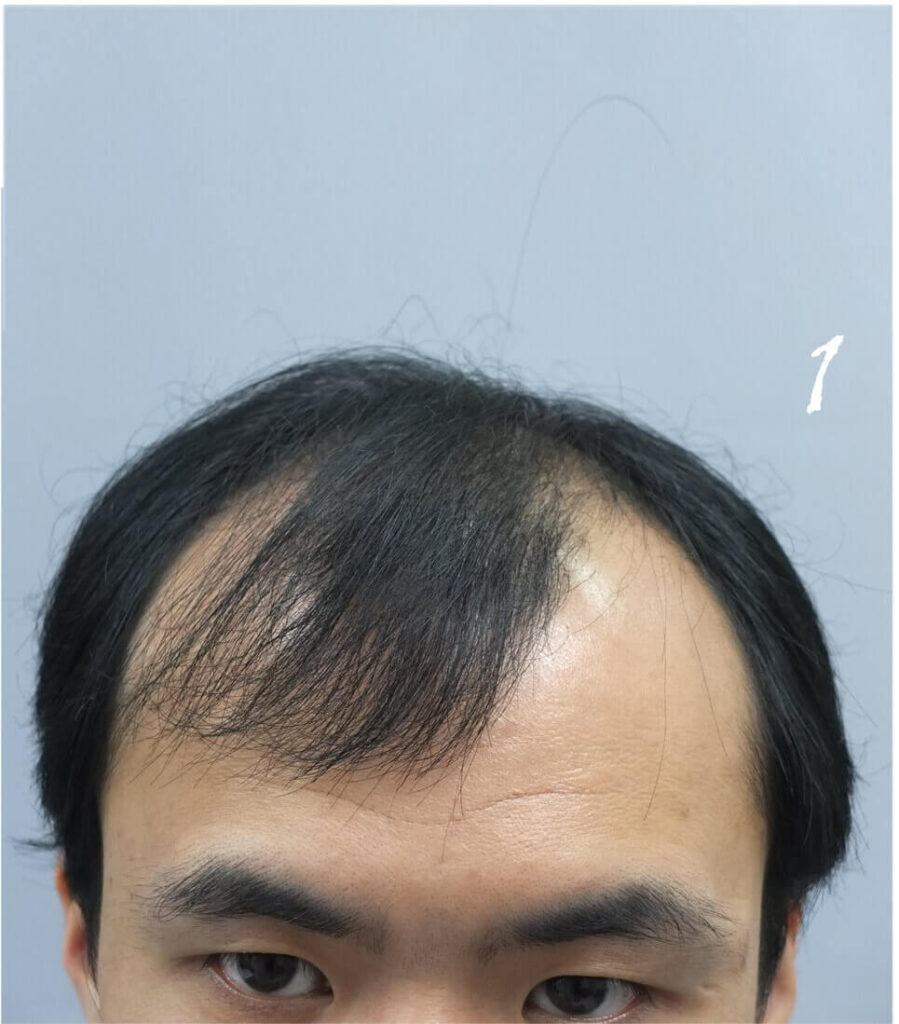
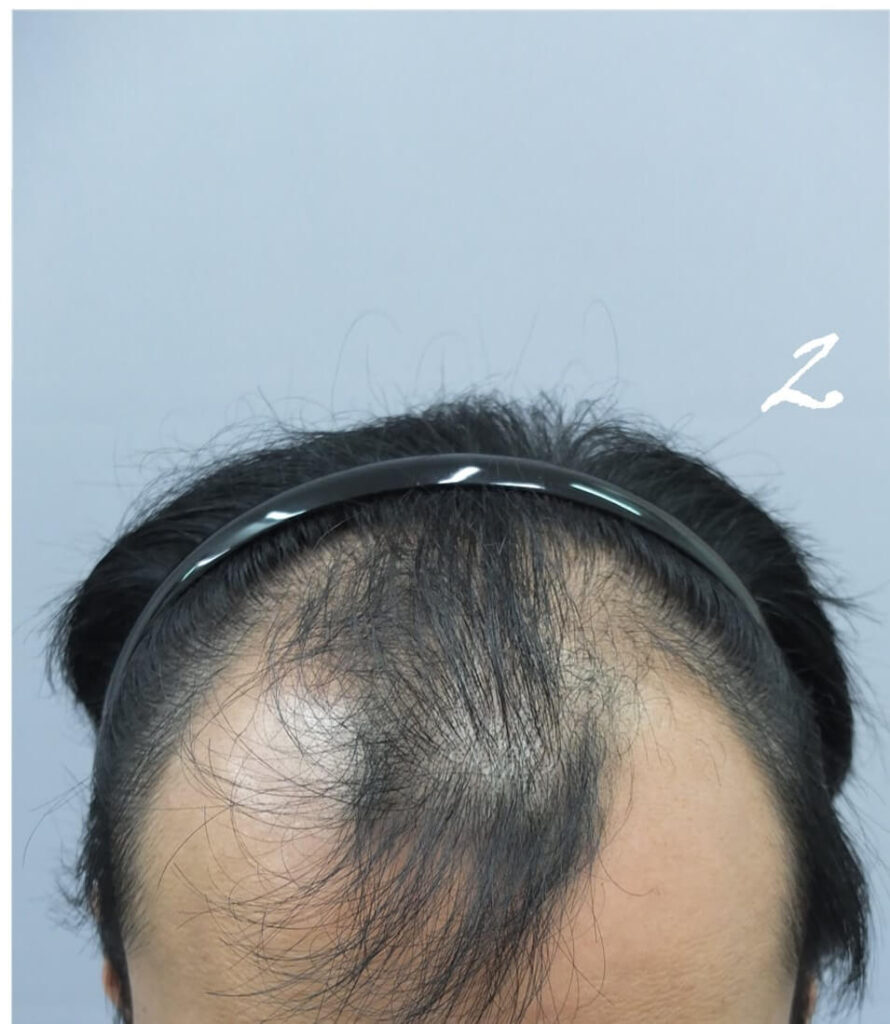
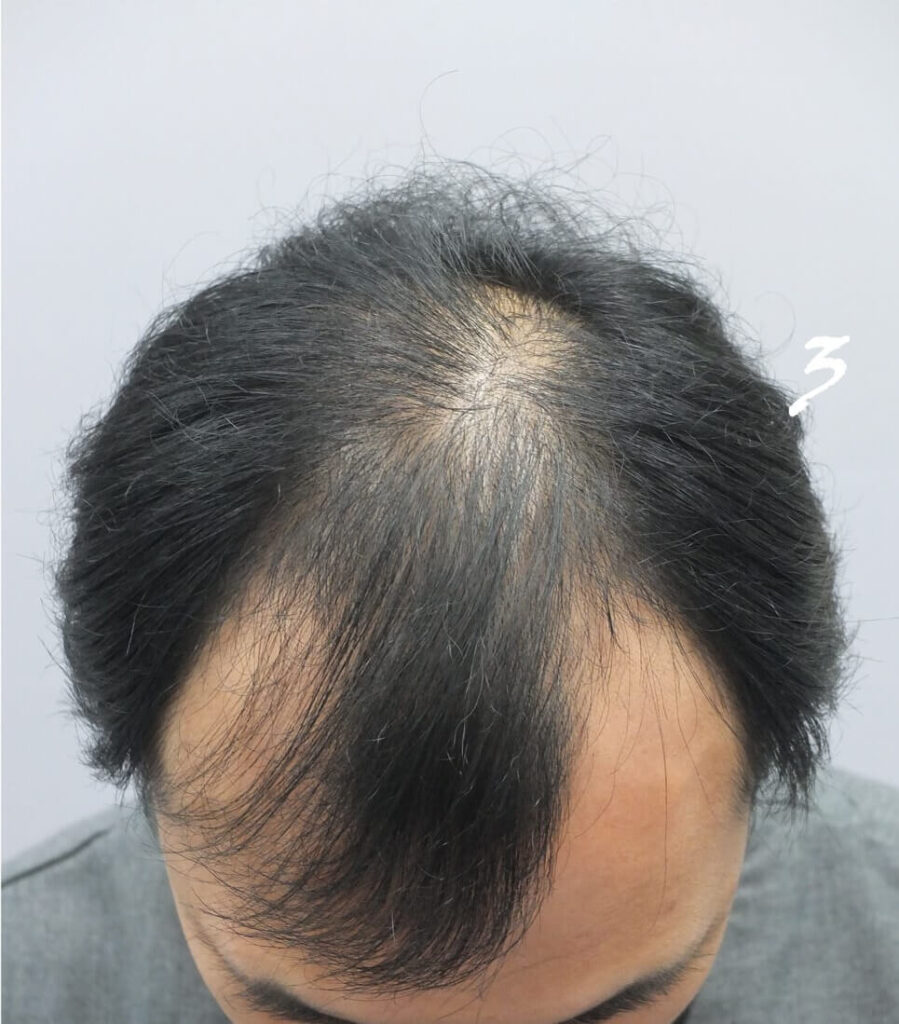
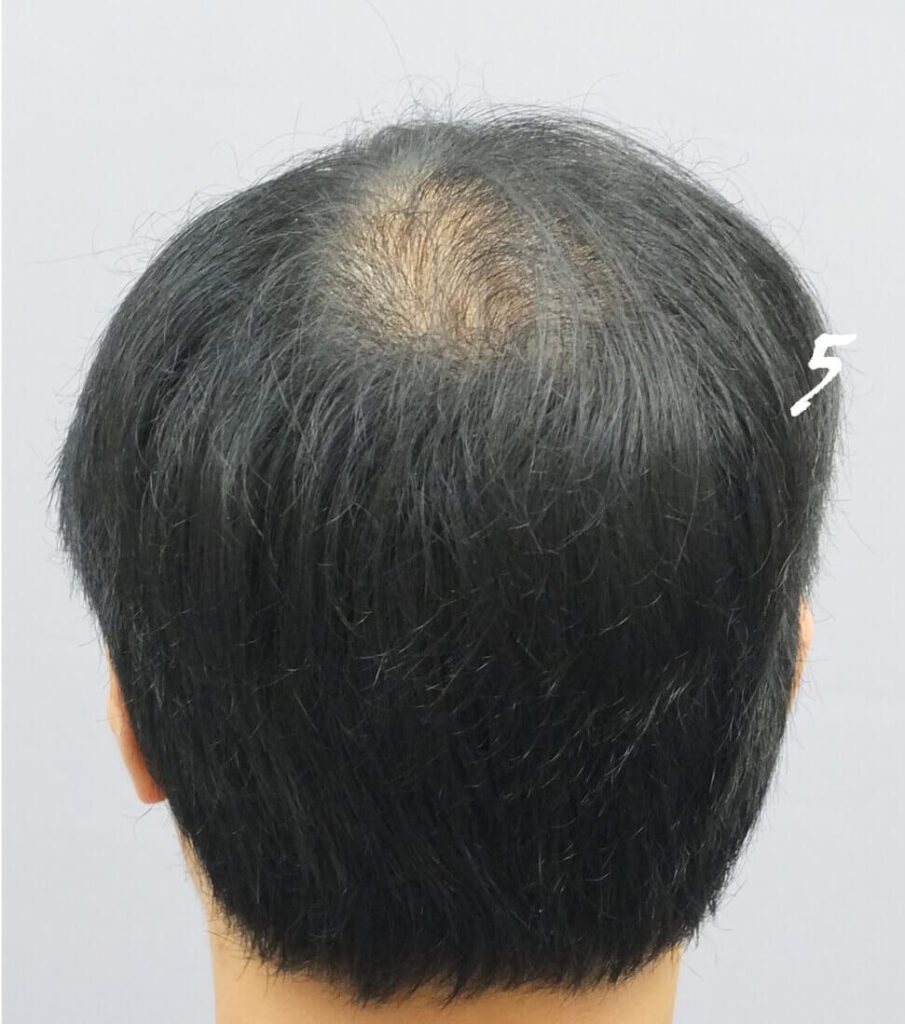
Before using our online assessment service, please read the following terms carefully. By submitting information through this platform, you acknowledge and agree to all the conditions listed below.
1. No Doctor–Patient Relationship Established
2. No Guarantee of Consultation or Procedure
3. Assessment Based on Provided Information
4. Mutual Cooperation is Essential
5. Dr. Bertram Operates as a Private Clinic
6. Patients are Free to Seek Other Opinions
7. Refusal is Based on Medical Grounds, Not Discrimination
The mainobjective of a doctor consultation is to build a doctor-patient relationship. Would the doctor who appear only on your day of procedure care about you and your result ?
Before deciding on an eyebrow transplant procedure, it is essential to consult with our doctors to ensure the best possible outcomes. A professional consultation provides an opportunity to assess your individual needs, discuss expectations, and explore potential results tailored to your facial structure.
The doctor can also address any underlying health concerns that might affect the procedure’s success. Moreover, this consultation helps in understanding the specifics of the procedure, recovery process, and any risks involved. Ensuring that all aspects are clearly understood and expectations are properly set with the expertise of a trained medical professional is crucial for a successful and satisfying eyebrow transplant experience.
Paying for a consultation ensures that you receive professional and unbiased advice from a skilled doctor who is focused solely on your needs and goals, without any obligation to proceed with the procedure. This fee covers the expert’s time and the valuable medical assessment they provide, helping you make an informed decision based on their objective opinion.
At our clinic, we maintain a no hard-sell policy to ensure that the consultation is an independent service, not merely a precursor to treatment. This approach underscores our commitment to ethical practices and the high value we place on both our services and your healthcare journey.
Just as there is no free lunch, expert medical advice from a trained professional is inherently valuable, and it’s reasonable for such expertise to be recognized and compensated.
Our doctor will take a detail history regarding
He will examine your scalp and hair, checking:
He will discuss the pros and cons of the various options:
Doctor will not offer hair transplant unless:
He will design a hairline best suit your look
He will discuss in detail:
Our doctor will take a detail history regarding
He will examine your scalp and hair, checking:
He will discuss the pros and cons of the various options:
Doctor will not offer hair transplant unless:
He will design an eyebrow best suit your look
He will discuss in detail:
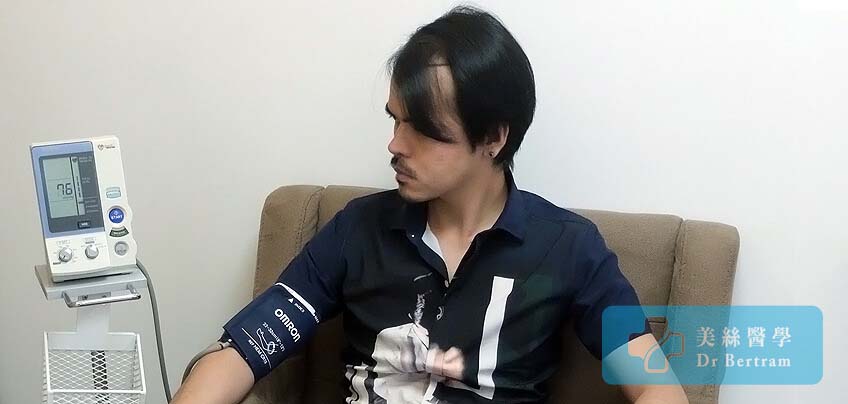
On the day of your procedure, our entire team will be dedicated to your personal care. They would ensure that your procedure is conducted smoothly and safely.
Technical staff may also greet you, collect your paperwork, advise you on how your day will unfold and answer your questions. When you arrive for your operation, a technician will provide you with a surgical garment and will wash your hair and scalp with a disinfecting shampoo. During your procedure, your team will ensure your comfort, make sure you get breaks when you need them, make sure you are not thirsty and will order a nice lunch for you.
You have plenty of time to clarify any concern. The procedure will be explained again signing a consent. It’s just like any other medical treatment. Inform the doctor regarding any drug allergy.
To reduce bacterial colonization on the scalp we wash your hair one more time with antiseptic.
Two types of medicine will be given: a pain-preventer and a relaxant. We do not use antibiotic as routine as we have successfully cut down postoperative infection to less than 1%. The relaxant helps to reduce any anxiety or discomfort during the procedure.
Now is the time to re-confirm what you want. The Doctor will design the hairline for you. Total area is measured again to estimate the final count. The surgical plan must be agreed and approved by you commencing the procedure.
The doctor will examine your occipital area carefully looking for permanent hair. The donor area ia then marked.
We trim the donor hair and count the density with a computer device called Folliscope. The length and width of the strip can then be accurately measured.
You will be lying face down during donor harvesting. Our hair transplant chair will provide you comfortable support. Most patients just fall asleep and then wake up for lunch.
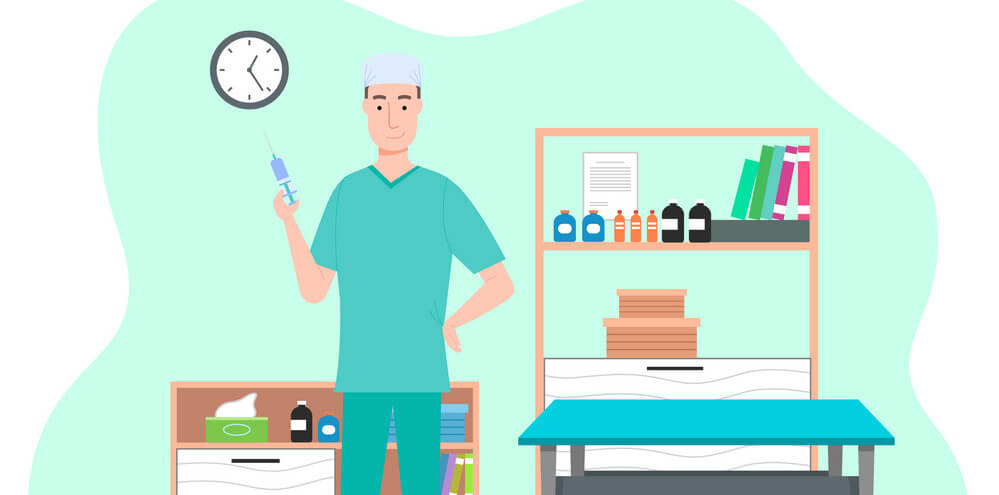
Our procedure is performed under local anesthesia without any intramuscular or intravenous injection. This is Level I Conscious Sedation in accordance to the American Standard outlined in the MASSACHUSETTS MEDICAL SOCIETY OFFICE-BASED SURGERY GUIDELINES. Minimal oral relaxing medications are given and during procedure.
A monitor is connected to check you body response during injection to ensure safety.
Massage, vibration, ice cube are very effective measures to distract you from feeling pain during injection. We are using the very small 30G needle and special technique. Inject very slowly is the key to minimize any discomfort.
Specially prepared fluid called Tumescence is injected to lift the skin up and away from the bone. This prevent any possible damage to the deep seated nerves and blood vessels, and provide good skin turgor for easy dissection.
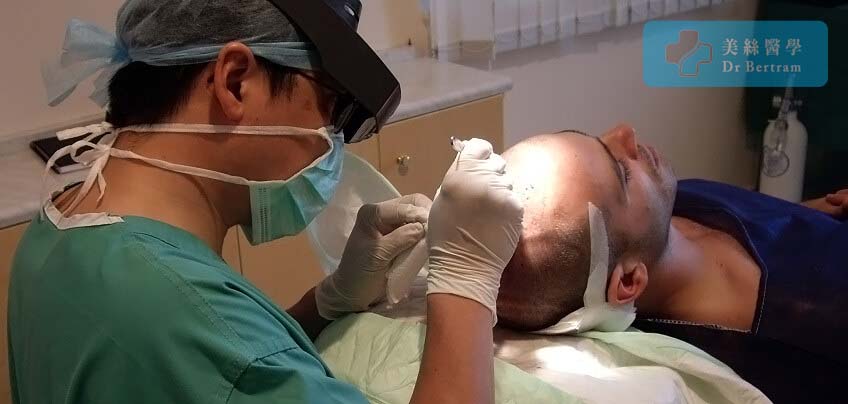
We use our own designed titanium FUE punch. Size 0.8mm in diameter is used for Asian thicker Hair, whilst 0.7mm is reserved for Caucasian. This size keeps grafts intact yet leaves minimal scar. Depth control is set to avoid graft transaction. We use both manual and automatic FUE depending on hair character. Every graft is extracted one-by-one carfefully not to damage any follicle.
We dissect the strip with a single blade using magnified loupes. The blade is angled parallel to the hair follicles to minimize transection. Excision is made quite superficially with minimal bleeding. We use the Trichophytic Technique described by Dr Frechet with 2 layers suturing to maximize approximation and to minimize scar.
The strip is then sent to our assistants to be dissected under 10X microscopic magnification into individual graft. Each graft contains 1 hair ( 1-hair FU-graft ), 2 hairs ( 2-hair FU-graft ), or 3 hairs ( 3-hair FU-unit-graft ). The intact follicles are stored in ATP enriched saline to maximise graft survival.
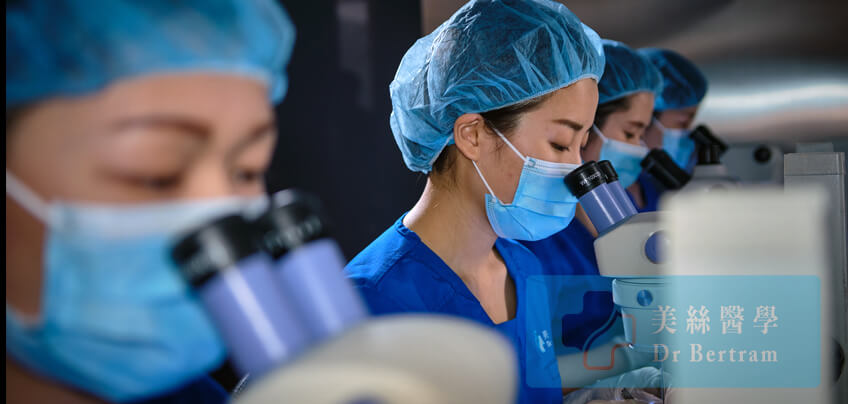
The extracted grafts are sent to our assistants with all redundant tissues trimmed under 10X microscopic magnification. The follicular unit grafts are then sorted into 1-hair FU, 2-hair FU, 3-hair FUs. Follicles are stored in ATP enriched saline to maximise graft survival.
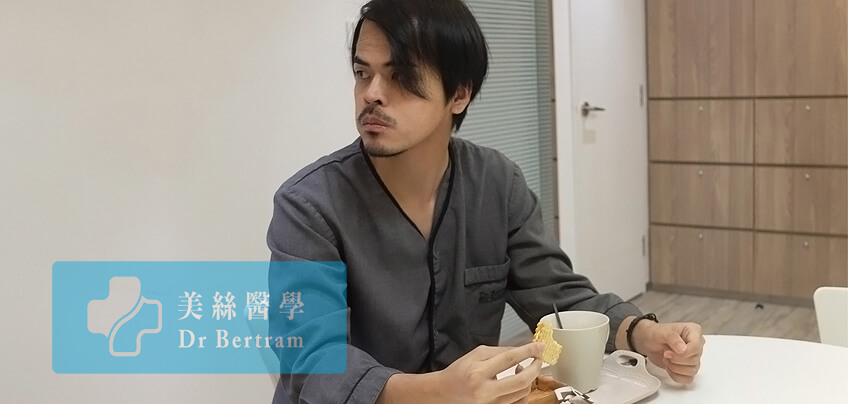
20 minutes break to enjoy your free lunch and return call. We can show you the grafts under a microscope.
We inject tumescence to lift the skin from the bone. This avoids damage to the deep seated nerve and vessels when making incisions. Our solution is formulated to prevent Ischaemic Reperfusion Injury to the grafts and postoperative facial swelling.
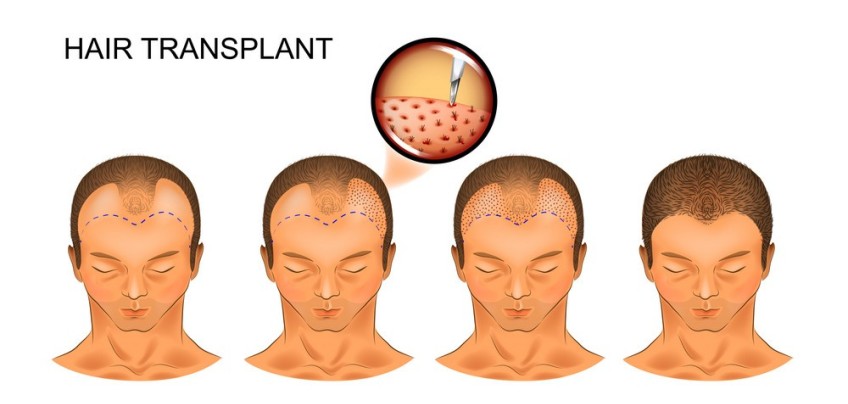
Incision is the creating of small pockets in the skin (called a slit) to accommodate the graft. Slit sizes range from 0.7 to 1.2mm. The doctor studies the angle, direction, and orientation of your existing hair in the recipient area. Incision and insertion must be planned to mimic your natural hair flow. Loupes are worn to magnify the surgical field and prevent damage to existing hair follicles. Incision is the most important step in the entire hair transplant procedures as the slits determined the final hair direction.
Grafts outside the body has a limited survival time and must be implanted ASAP. Currently we are using 3 different Isertion Techniques.
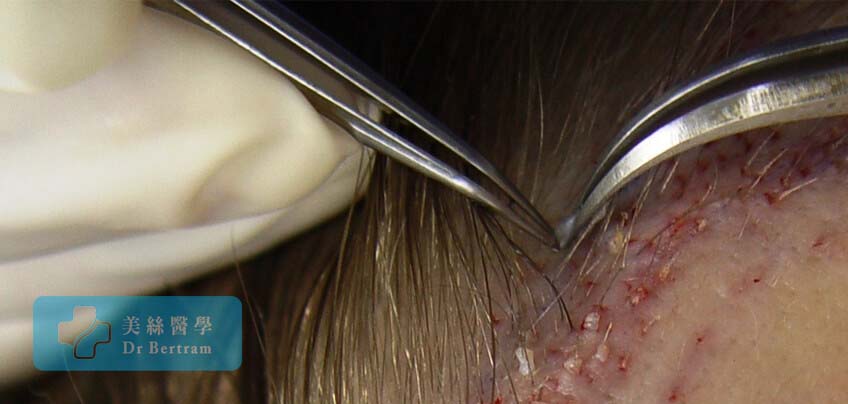
Fine tips forceps gently grasp the shaft and inserted the graft into a snug-fit holes as 1 step without touching the fragile root. This allows for denser packing avoiding any trauma to the follicle. It’s our preferred method.
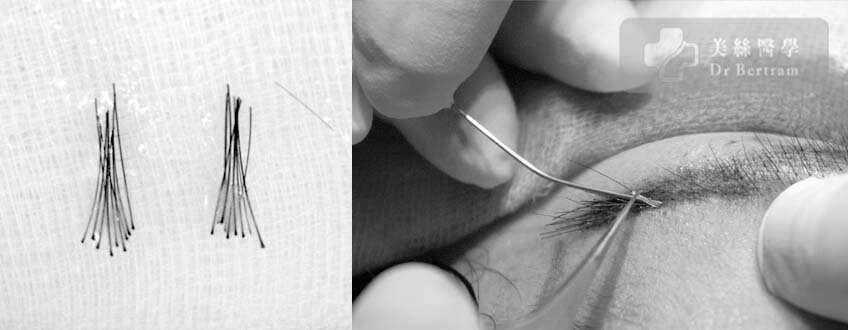
For dense packing we have to eliminate any empty spots between hairs. We keep about 10% of grafts at the end to fill in these spaces. After creating a slit a graft is inserted immediately. This technique of Stick and Place allows more grafts to be inserted per area.
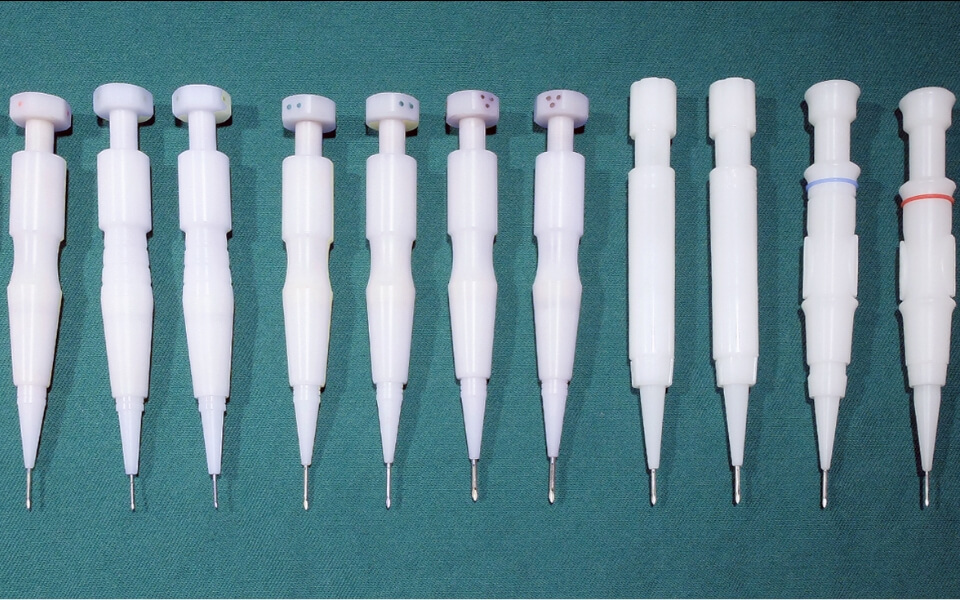
This is commonly used in Korea and Japan, especially for those using FUE. The follicle is first dragged into its metal tube inserting the implanter into a slit. On withdrawal the graft is pushed out and left in the slit. We have abandoned implanter because of 2 reasons:
Obviously that depends on the number of grafts. Even 3,000 grafts may just take 8 hours. However if you have to take frequent breaks or cannot keep still, more time is required. We reserve the whole day for you to ensure the procedure is accomplished to full satisfaction.
Some of the grafts may be dislodged during the procedure. On completion we spend another 20 minutes double- checking every graft. Any loosen ones will be re-inserted to ensure maximum survival.
For large session or the crown we may put a dressing overnight. Otherwise a head band will be applied.
Most patients are fully awake by the end of the procedure. A cup of coffee usually helps. We will check and make sure you are in good condition letting you do. There is a taxi stand within 2 minutes walk just across the street.
Hair transplant is not just a cosmetic service — it’s a medical procedure with real risks. That’s why our clinic ensures your entire journey is doctor-managed, including post-op care. When complications happen — even rare ones like infection, poor growth, or graft loss — you need a qualified doctor who:
Personally performed your procedure and understands every detail
Can spot early signs of trouble and act fast
Has the authority to adjust medications and treatment safely
Takes full responsibility for your outcome — no excuses, no handoffs
This is not just better care — it’s the care you deserve.
Most post-transplant complications can be avoided — if they’re caught early. That’s why our aftercare isn’t left to chance or handled by consultants. Every patient follows a structured, doctor-led protocol designed to:
Detect early signs of infection, inflammation, or poor healing
Adjust medications based on your body’s unique response
Resolve small issues before they become big setbacks
Only a qualified doctor can tell the difference between normal healing and the first sign of trouble. We don’t just fix problems — we prevent them. That’s the power of medical care, not customer service.
We provide round-the-clock support during the most critical period after your procedure. Follow our instructions carefully to ensure the best results.
📞 Call our 24-Hour Hotline anytime if you’re concerned.
Most patients find discomfort tolerable without medication
For those who need it, we provide simple painkillers as required
Stronger pain relief is available upon request
Tightness around the donor wound will ease after the sutures are removed
The scalp sits close to the bone with minimal cushion
To protect it, we inject a special fluid during surgery to lift the skin slightly
This fluid may drain toward the forehead or around the eyes after 3 days
If swelling appears, it may take about a week to resolve
Our custom-designed headband is proven to reduce this swelling effectively
Your package includes 2 sessions of LLLT
Clinical studies show that LLLT enhances wound healing and reduces shock loss
Your first session is scheduled for the day after surgery, after your hairwash
We provide round-the-clock support during the most critical period after your procedure. Follow our instructions carefully to ensure the best results.
📞 Call our 24-Hour Hotline anytime if you’re concerned.
Be cautious when entering vehicles — do not bump your head on the door rim or roof
Transplanted grafts can be dislodged with impact
Watch out for cupboard doors or any low overhead surfaces as well
Whether FUT or FUE, you can sleep normally in bed
Mild tightness in the donor area is normal
If lying on a pillow feels uncomfortable, roll a towel under your neck or use a neck pillow
Painkillers can be taken before sleep
Sleeping pills are also available if needed
Most patients find discomfort tolerable without medication
For those who need it, we provide simple painkillers as required
Stronger pain relief is available upon request
Tightness around the donor wound will ease after the sutures are removed
The scalp sits close to the bone with minimal cushion
To protect it, we inject a special fluid during surgery to lift the skin slightly
This fluid may drain toward the forehead or around the eyes after 3 days
If swelling appears, it may take about a week to resolve
Our custom-designed headband is proven to reduce this swelling effectively
We use a waterproof technique, so you can wash the transplanted area daily
Our staff will demonstrate the proper way to wash your hair the day after surgery
Keeping the area clean reduces the risk of infection and speeds up healing
Your package includes 2 sessions of LLLT
Clinical studies show that LLLT enhances wound healing and reduces shock loss
Your first session is scheduled for the day after surgery, after your hairwash
Recovery is usually smooth, and most patients return to their normal routine within days. Follow these simple guidelines for the best healing experience.
Avoid heavy meals on the night after surgery — mild nausea is common
You can eat normally, but try to avoid excessively salty foods for the first 3 days
This helps reduce swelling around the forehead and eyes
You can resume light outdoor activities as early as the next day
Most patients feel comfortable returning to work within 2 to 3 days
If your job is physically demanding or involves sweating, we’ll give tailored advice
You may feel tightness or discomfort where the strip was taken — this is normal
Sutures are critical to minimize scarring and ensure proper healing
We use two types of sutures:
One is removed on Day 5 to 7, either at our clinic or by your local doctor
The other is self-dissolving, usually gone within 4 weeks
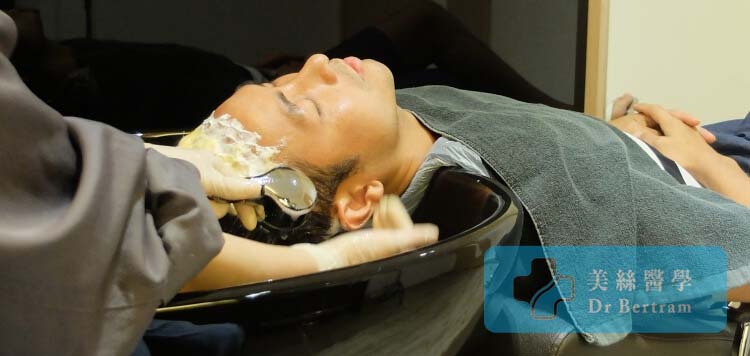
We use a waterproof technique, so you can wash the transplanted area daily
Our staff will demonstrate the proper way to wash your hair the day after surgery
Keeping the area clean reduces the risk of infection and speeds up healing
Hair washing may seem simple — but after a transplant, technique is everything. In the first 7 days, the grafts are still building blood supply and remain fragile. Incorrect washing can dislodge grafts and affect your final result.
At our clinic, we treat hair washing as a clinical skill — not a casual routine.
During his advanced fellowship training, Dr. Bertram Ng devoted weeks mastering post-transplant care, including proper washing methods. Every member of our team is personally trained by Dr. Ng to ensure gentle, professional aftercare.
Two dedicated shampoo rooms in our clinic
Trained hair care professionals available post-procedure
On the first day after surgery, we’ll demonstrate the correct washing method so you can confidently continue care at home.
Small red dots appear at graft sites in the first few days
These dry into brown crusts, which are normal
With proper washing, crusts naturally fall off without damaging grafts
If neglected, scabs may cause itchiness, infection risk, or poor healing
Not all shampoos are safe post-transplant.
Avoid products with harsh chemicals or strong fragrance
Our clinic will recommend a gentle, medically safe shampoo
These support healing, protect grafts, and keep your scalp comfortable
We don’t just perform the procedure — we walk with you every step of the recovery.
You’ll receive a comprehensive care kit including:
Medications
Written step-by-step instructions
ATP spray to support cell vitality
Gentle shampoo for safe scalp cleansing
Our team provides ongoing support:
Daily follow-up as needed
Clear contact point for any concerns
Guidance customized to your healing progress
By closely following your post-op plan and staying connected with our clinic, you give your new hair the best possible start.
Thanks to our gentle techniques and doctor-led care, recovery is smoother than most expect. Most of our patients experience very little discomfort and can return to light activities within a few days. Many of our patients go back to work in just 2–3 days.
Recovering from a hair transplant is a delicate process, and what you do after the procedure is just as important as the surgery itself. To protect your newly transplanted grafts and ensure the best possible results, it’s essential to follow the specific activity guidelines we provide.
Even simple daily activities — such as exercising, bending over, or exposing the scalp to heat and sweat — can affect graft survival if not managed properly.
By carefully following our instructions, you not only reduce the risk of complications but also maximize your hair growth outcome.
Our guidelines are designed to support your scalp’s healing, minimize discomfort, and safeguard your investment in your appearance and confidence.
Minimal Downtime, Quick Recovery.
Thanks to our gentle techniques and doctor-led care, recovery is smoother than most expect. Most of our patients experience very little discomfort and can return to light activities within a few days. Many of our patients go back to work in just 2–3 days.
ACTIVITIES |
DAY AFTER PROCEDURE |
|---|---|
Wearing Hat or Banada | - Same Day on Discharge |
| Indoor Activities | - Next Day (Day 1) |
| Shopping, Dining Out | - Next Day (Day 1) |
| Hair Wash at Home | - Day 2 (Day 1 we shampoo for you) |
| Travel by Plane | - Day 2 (We had patients leaving that same evening) |
| Drink Alcohol | - Day 2 |
| Office Work | - Day 2 |
| Light Exercise (Tai Chi) | - After 1 week |
| Golf | - After 1 week |
| Hair Styling Gel / Spray | - After 1 week |
| Wearing Hairpiece / Wig | - After 1 week |
| Resume Minoxidil Lotion | - After 10 days |
| Moderate Exercise (jogging) | - After 2 weeks |
| Hair Cut / Dye | - After 4 weeks; |
| Strenous Exercise (weight lifting, soccer) | - After 4 weeks |
| Swimming (pool or beach) | - After 4 weeks |
| Sauna | - After 3 - 4 months |
With our advanced hair transplant technique, most patients can resume light daily activities within days. But when it comes to gym workouts or physical training, it’s important to follow a gradual plan to protect your grafts and support healing.
Here’s a general timeline — always follow your doctor’s personalized advice for the best results.
First Week
❌ Avoid all strenuous activity, including gym workouts
✅ Light walking is encouraged to promote circulation without straining the scalp
After 1 Week
✅ Begin with light movements — walking, stretching, or gentle yoga
❌ Still avoid anything that causes sweating or increased blood pressure to the scalp
After 2 Weeks
✅ Introduce low-impact exercises: stationary bike, light weights
❌ Avoid intense cardio, hot environments, or movements that increase scalp pressure
After 3 Weeks
✅ Resume moderate-intensity workouts, with caution
❌ Avoid heavy lifting, contact sports, or exercises involving deep bending
After 4 Weeks
✅ Most patients can return to their full gym routine
✔️ Continue monitoring for any discomfort or scalp sensitivity
Listen to your body — stop if you feel discomfort
Keep the scalp clean and dry during workouts
Use a soft headband to absorb sweat without pressure
Always consult our team if you’re unsure or have questions
Swimming is best avoided during the early healing period — but with proper timing and care, you’ll be back in the water soon.
Here’s a general guideline to help you know when and how to safely return to swimming after your procedure. Always follow your doctor’s personal advice.
First 3 Weeks
❌ Avoid all swimming — whether in pools, the sea, or public baths
❌ Submerging the scalp can increase the risk of infection, irritation, or graft disturbance
After 3 Weeks
✅ You may begin gentle swimming in a pool, with caution
❌ Avoid full submersion and limit exposure to chlorinated water, which may irritate healing skin
After 4 Weeks
✅ You can resume light swimming, ideally wearing a swim cap for added protection
✅ Rinse your scalp immediately with clean water after swimming to remove chlorine or salt
❌ Still avoid long exposure to sunlight, heat, or heavily chlorinated pools
After 5 Weeks and Beyond
✅ Most patients can swim more freely in pools or the sea
☀️ Use sunscreen or a hat to protect your scalp from UV rays
❗ Always monitor for any signs of irritation or discomfort
Follow your doctor’s individual timeline — especially if you had FUT or if healing was slower
Be gentle when washing your scalp after swimming
If you notice redness, oozing, or sensitivity, stop and consult our clinic immediately
Swelling and Bleeding
Physical exertion raises blood pressure, which can lead to swelling and post-op bleeding.
Rest helps reduce these risks.
Graft Displacement
Sudden movements, bending, or lifting can loosen newly placed grafts before they fully anchor.
Infection from Sweat or Dirt
Avoiding excessive sweat and unclean environments protects the scalp from bacteria during its most vulnerable phase.
Delayed or Poor Healing
Adequate rest allows the body to direct energy toward healing and graft survival — key to long-term success.
Thanks to our gentle techniques and doctor-led care, recovery is smoother than most expect. Most of our patients experience very little discomfort and can return to light activities within a few days. Many of our patients go back to work in just 2–3 days.
Recovering from a hair transplant is a delicate process, and what you do after the procedure is just as important as the surgery itself. To protect your newly transplanted grafts and ensure the best possible results, it’s essential to follow the specific activity guidelines we provide.
Even simple daily activities — such as exercising, bending over, or exposing the scalp to heat and sweat — can affect graft survival if not managed properly.
By carefully following our instructions, you not only reduce the risk of complications but also maximize your hair growth outcome.
Our guidelines are designed to support your scalp’s healing, minimize discomfort, and safeguard your investment in your appearance and confidence.
Making incisions temporarily traumatize the very superficial nerves. This may lead to numbness or pins-and-needles sensation. In a sense it is good as you won’t feel any pain in the transplanted area. The course varies amongst patients, lasting from weeks to months. It does not affect your daily activities, felt only when touched. Full recovery is the rule.
The generous use of tumescence
• Set a depth guard to the blades to avoid too deep penetration
• Keep the entry angle of the blade rather flat to the skin
• Avoid overdose of local anesthesia
• Reassurance of full recovery
This is the well known Shock Loss with shedding of existing hair within and around the transplanted area.Usually affects women with weak miniaturized hairs. Hair loss begins about 1 month and continue for 2-3 months. Re- growth may not be a 100%. Appearance improves when the transplanted hairs start to grow.
Warn every patient. Those unable to tolerate shock loss are refused surgery
• Select patients carefully, and exclude those with diffuse hair thinning
• Apply Minoxidil to the area before and after surgery
• In men shaving the transplanted area is the best prevention
• Avoid transecting pre-existing hair follicles during incision
• Avoid dense packing
• Women may wear a hair piece while waiting for hair re- growth.
Shedding of hair below and above the sutured line, usually occurs 2-4 weeks after surgery. This is extremely unpredictable though the risk is higher if the wound is undermined and closed under tension. Full recovery is the rule but may take 4 months to re- grow.
Every patient is warned
• Keep at least 1 inch of hair at the donor area for cover-up
• Apply Minoxidil to the area before and after surgery may help
• Do not cut hair for a month after surgery.
• Reassurance of full recovery
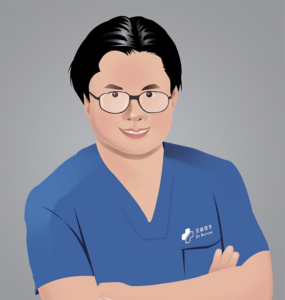
A proper hair transplant procedure should start with a thorough assessment to understand your hair loss concerns. Do not jump into any surgery until you fully understand the pros and cons, and if available any alternative non-surgical treatment.
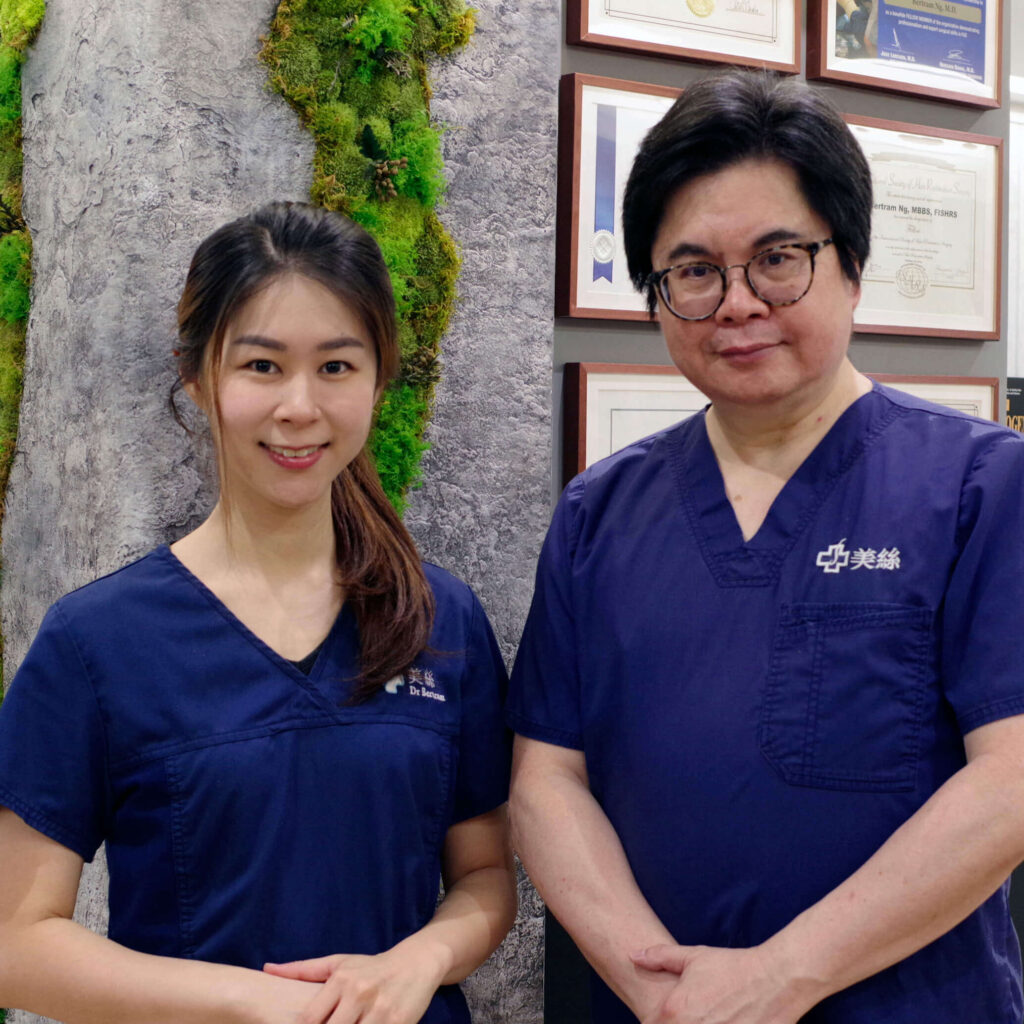
From consultation, surgery, to aftercare, you will receive continued personal care by our doctors, not just consultants.
Have a question? Please feel free to call our friendly customer service.
International Accreditations
Recognized by leading global medical bodies, our clinic stands as one of the most qualified and internationally accredited hair transplant centers in Hong Kong and mainland China. We are proud to uphold the highest standards in medical ethics, safety, and surgical expertise.
Hair transplant is the ultimate solution to restores hair, but not everyone is good candidate.
Our online assessment helps determine if these procedures suit you, saving you time and costs.